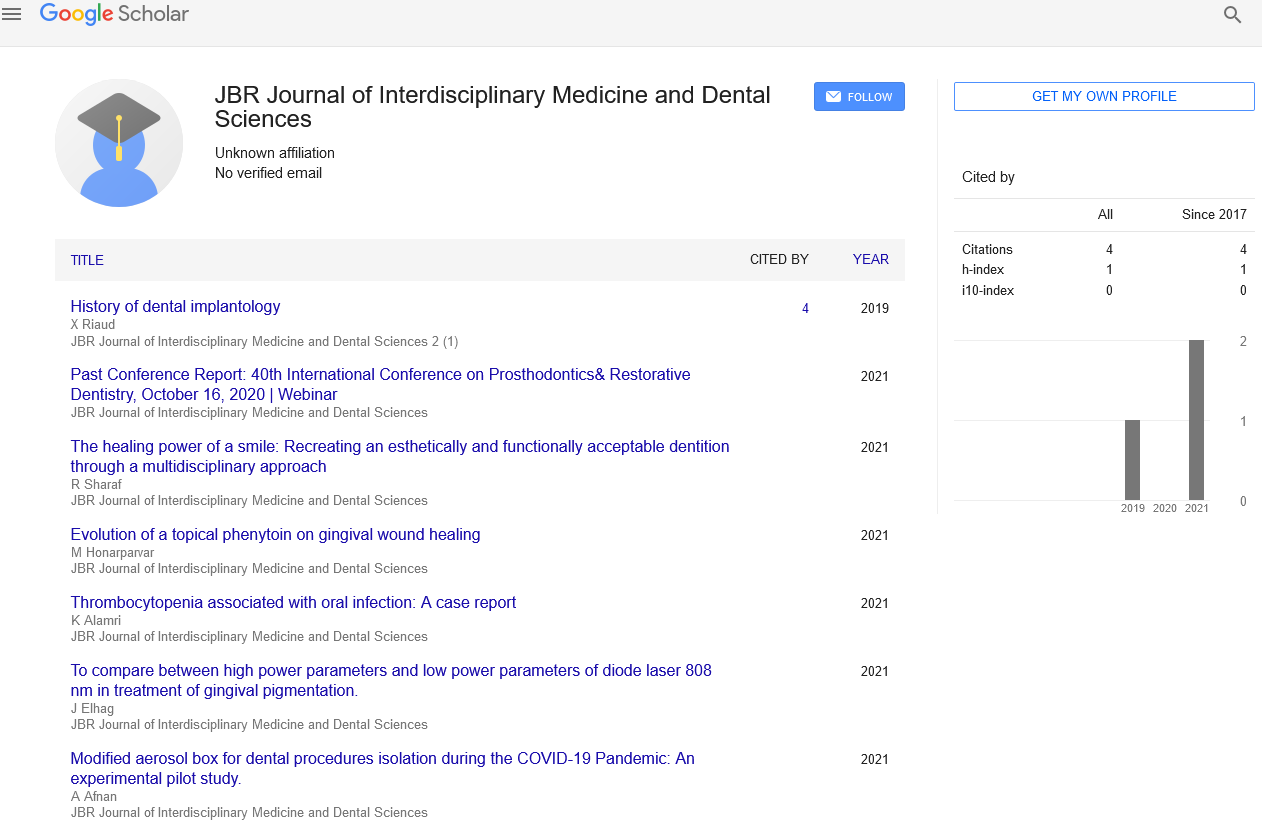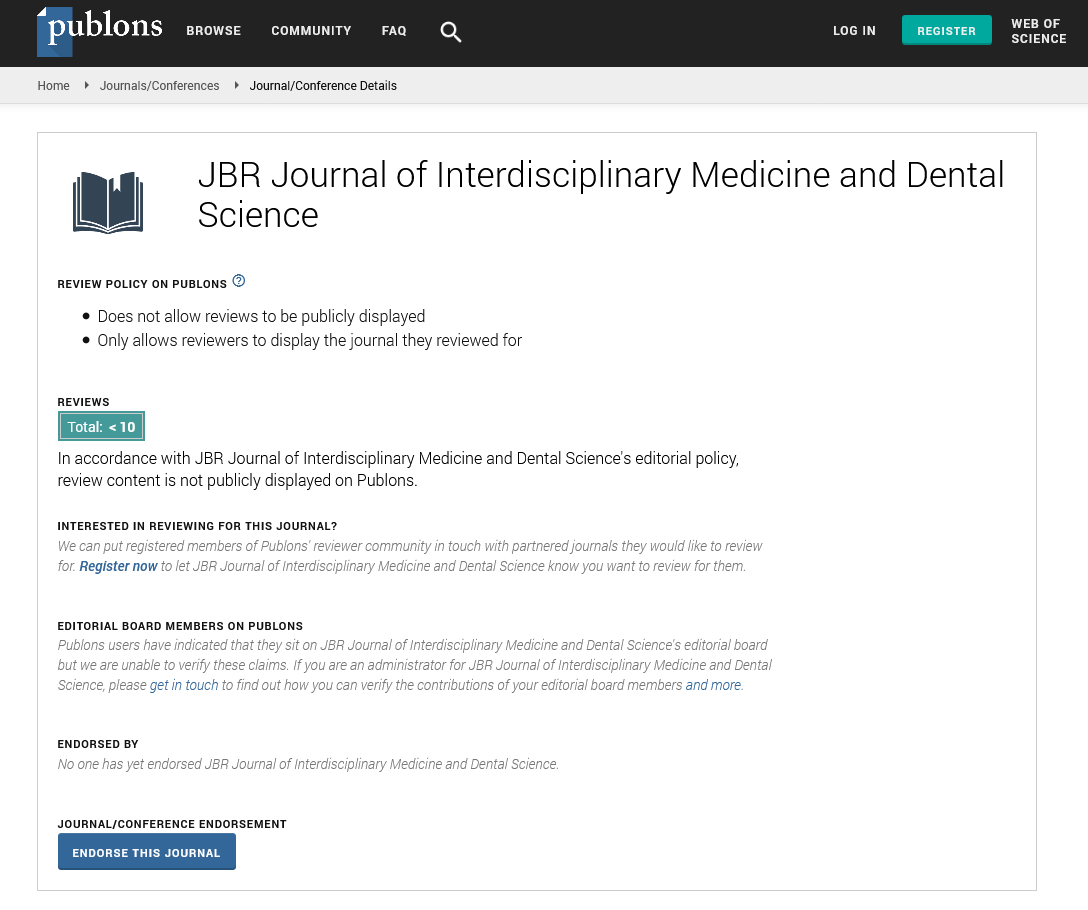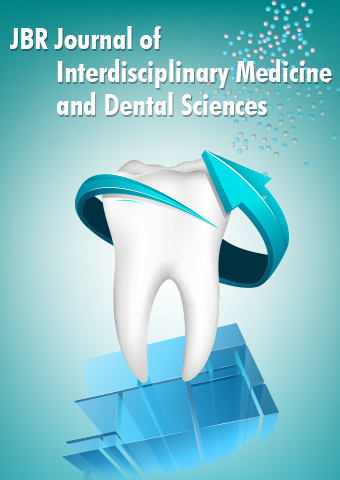Mini Review - JBR Journal of Interdisciplinary Medicine and Dental Sciences (2023) Volume 6, Issue 1
Different surface treatments' effects on the colour stability of various dental porcelains
Jiyah Ahmet*
Department of Prosthodontics, Turkeyn
Department of Prosthodontics, Turkeyn
E-mail: ahmetjiyaj3333@rediff.com
Received: 02-Jan-2023, Manuscript No. JIMDS-23-85872; Editor assigned: 04-Jan-2023, PreQC No. JIMDS-23-85872 (PQ); Reviewed: 18- Jan-2023, QC No. JIMDS-23-85872; Revised: 23-Jan-2023, Manuscript No. JIMDS-23-85872 (R); Published: 30-Jan-2023, DOI: 10.37532/2376- 032X.2023.6(1).04-06
Abstract
The few research reporting on the stainability of dental porcelain materials are deficient in information. The effects of polishing techniques and staining agents on the colour stability of dental porcelains, however, have not been examined in any studies. This study’s objective was to assess how various polishing methods affected the colour stability of various dental porcelains. For feldspathic (Vita VMK 95, Ceramco III), low-fusing porcelain (Matchmaker), and machinable feldspathic porcelain blocks, fifty-five examples each were made (Vitablocs Mark II). The prepared specimens were divided into 11 groups (n=5) to represent various polishing techniques. These groups included a control group (no surface treatment), glaze, and nine others that were polished using a polishing disc (Sof-Lex), two porcelain polishing kits (NTI, Dialite II), a diamond polishing paste (Sparkle), a zirconium silicate-based cleaning and polishing prophy paste (Zircate), an aluminium oxide polishing paste (Prisma Gloss) Samples were kept in a coffee solution at 37â°C for 48 hours. A colorimeter was used to quantify the colour of each specimen both before and after exposure, and colour changes (DE) were computed. Data were examined using a two-way analysis of variance, and the Tukey’s honest significant difference test was used to compare mean values. Ceramco III has the greatest DE value among the four distinct porcelain materials. The porcelain material groups of Mark II, Matchmaker MC, and VMK 95 showed no discernible differences (P=0.074). For all of the studied porcelain materials, Group Gl had the lowest DE values when comparing the polishing methods. Groups Sl, Di, and Pk showed no significant differences (P=0.883), while Group Gl had considerably lower DE values than these groups (P<0.05).
Introduction
Because of its benefits of biocompatibility, endurance, durability, and outstanding aesthetic qualities with long-term usage, porcelain has emerged as a key component in restorative dentistry. Natural teeth are similar in their translucency, colour, and intensity to porcelain materials. As a result, restorations for healthy living might have a glazed-porcelain surface texture that resembles individual teeth. Sometimes porcelain restorations need to be adjusted, which results in the porcelain’s glazed surface breaking. Unglazed porcelain surfaces can aggravate gingival tissue, collect plaque, exacerbate surface stains, and wear down the opposing teeth excessively. It is necessary to reglaze or polish the roughened surface. Numerous researches on polishing and completing dental ceramics have been published, but few have examined the efficacy of various polishing methods for more recent forms of dental porcelain, such as Mark II porcelain blocks [1].
The surfaces of a ceramic restoration usually require thorough intra-oral polishing since the final occlusal correction must be accomplished after cementation. Since a glazed surface is optimal, small imperfections in the porcelain surface may be fixed in clinical settings by polishing rather than reglazing [2]. One crucial clinical criterion for assessing new porcelain is its stain resistance. The American Dental Association (ADA) specification no. 69 for dental porcelains for all ceramic restorations contained a subjective method of evaluation. Consistent colour assessments can be obtained from colour measurements made using a colorimeter. The Commission Internationale de’lEclairage (CIE) Lab Color System, a system the CIE devised in 1978 for describing colour based on human perception, is frequently used by colorimeters to describe colour [3].
Three attributes—L*, a), and b)—are added to the perception of colour by the CIE Lab colour system. L) Denotes the brightness variable and is inversely proportional to Munsell Color System values. The chromaticity coordinates a) and b) relate to the red-to-green-to-yellow axis and the blue-to-yellow-to-blue axis, respectively. The corresponding numerals help to establish numeric correlates for hue and chroma even if they are not direct correlates to these properties. A positive a) value corresponds to a color’s degree of redness, whereas a negative a) value corresponds to a color’s degree of greenness. In contrast, a negative b) number reflects how much blueness there is in an object, whereas a positive b) value indicates how yellow it is. Because it is effective at identifying subtle colour changes, the CIE Lab method for measuring chromacity was used for the current investigation to record colour differences [4]. Despite its drawbacks, the quantitative examination of colour differences (DE) with a colorimeter provides benefits including reproducibility, sensitivity, and objectivity. In theory, no colour variation will be visible after a material has been exposed to the test environment if it is totally color-stable or uncolored (DE Z 0). Numerous researchers have identified various colour difference thresholds over which the human eye may detect and accept a colour shift. Visually unnoticeable and therapeutically tolerable is a DE score of 3.7 [5]. The majority of previous research on the colour of porcelain materials focused on how age, several firings, and the thickness of opaque and dentin porcelains affected the colour of the materials. Overabundances of composite resin materials were used to investigate the effects of staining agents on colour stability. The few research that has looked into the stainability of dental porcelain materials has a dearth of information. The effects of various polishing techniques and a staining agent on the colour of dental porcelains have not, however, been the subject of any investigations. This in vitro study’s objective was to assess the stainability of feldspathic and low-fusing porcelain materials, to which glaze, various polishing procedures, and their combinations have been applied. In this study, it was hypothesised that the use of various polishing procedures would affect how stain-resistant certain porcelain materials are. These were some of the limitations of the current investigation [6]. While porcelain restorations often have variable forms with convex and concave surfaces, the specimen surfaces were flat. The majority of the time, extra oral assessment specimens are monochromatic, evenly transparent, untextured, and lit optimally [7]. Conversely, teeth are multicoloured, irregularly transparent, textured, and seen intraorally in ambient illumination. Additionally, teeth are clinically framed next to one another with variable levels of translucency and polychromaticity. Additionally, it could be challenging to use the polishing techniques examined in this study in a therapeutic setting. Thermal cycling and abrasion are other variables that could have an impact on how much the overall colour changes. Future research should take this into account [8]. As a result, nothing is known about how various polishing methods and procedures affect the colour stability of porcelain materials. To assess how a newer variety of dental porcelains’ colour changes, more research is required [9].
Conclusion
After storing four porcelain materials in a coffee solution for 48 hours, the stain resistance of each was assessed. The following results were reached within the constraints of this investigation.
Feldspathic and low-fusing porcelain materials treated to the various polishing procedures examined showed significant variations in colour change (P < 0.05).
The Ceramco III porcelain was found to be less color- stable than the Mark II, Matchmaker MC, and VMK 95 porcelain materials [10]. The Ceramco III porcelain material showed the greatest colour variance. It was determined that these differences were significant t (P < 0.05). For all of the examined porcelain materials, glazed specimens showed less colour change than polished ones. DE values were shown to be at an acceptable level for all of the porcelain materials evaluated using glazed and polished specimens with various polishing techniques (1 < DE < 3.7).
References
- Sarikaya I, Güler AU. Effects of different surface treatments on the color stability of various dental porcelains. Journal of Dental Sciences. 6, 65-71 (2011).
- Motro PF, Karagoz PK, Kazazoglu E. Effects of different surface treatments on stainability of ceramics. The Journal of prosthetic dentistry.108, 231-237 (2012).
- Sarıkaya I, Yerliyurt K, Hayran Y. Effect of surface finishing on the colour stability and translucency of dental ceramics. BMC Oral Healt.18, 1-8 (2018).
- Meral K, Bilge TB. Effects of accelerated artificial aging on the translucency and color stability of monolithic ceramics with different surface treatments. The Journal of prosthetic dentistr.121, 712-e1 (2019).
- Atay A, Karayazgan B, OzkanY et al. Effect of colored beverages on the color stability of feldspathic porcelain subjected to various surface treatments. Quintessence International.40 (2009).
- Kanat‐Ertürk, Burcu. Color stability of CAD/CAM ceramics prepared with different surface finishing procedures. Journal of Prosthodontics.29, 166-172 (2020).
- Derafshi R, Khorshidi H, Kalantari M et al. The effect of chlorhexidine mouth rinse on the colour stability of porcelain with three different surface treatments: An in vitro study. Journal of Dental Biomaterials.1, 3-8 (2014).
- Köroğlu A, Sahin O, Dede DO et al. Effect of different surface treatment methods on the surface roughness and color stability of interim prosthodontic materials. The Journal of prosthetic dentistr.115, 447-455 (2016).
- Atay A, Oruç S, Ozen J et al. Effect of accelerated aging on the color stability of feldspathic ceramic treated with various surface treatments. Quintessence International.39 (2008).
- Alp, Gulce. Effect of surface treatments and coffee thermocycling on the color and translucency of CAD-CAM monolithic glass-ceramic. The Journal of prosthetic dentistry120, 263-268 (2018).
Indexed at, Google Scholar, Crossref
Indexed at, Google Scholar, Crossref
Indexed at, Google Scholar, Crossref
Indexed at, Google Scholar, Crossref
Indexed at, Google Scholar, Crossref
Indexed at, Google Scholar, Crossref
Indexed at, Google Scholar, Crossref


